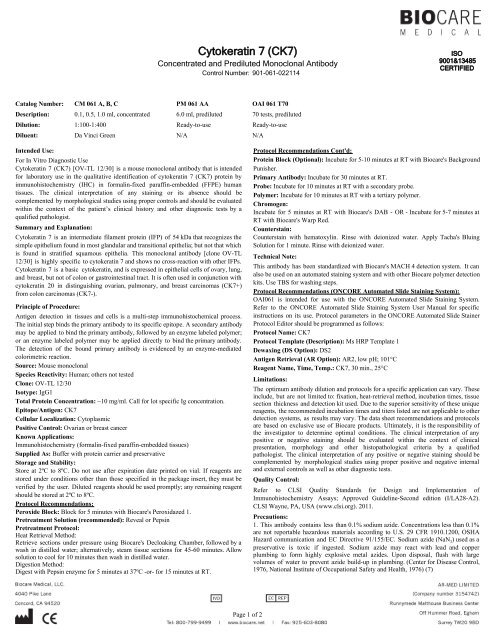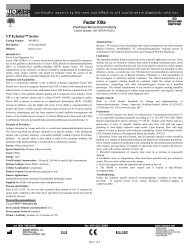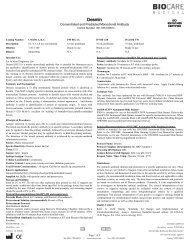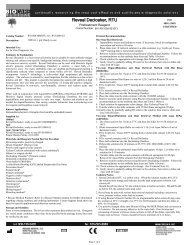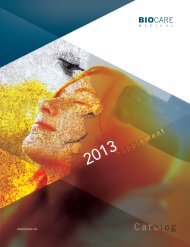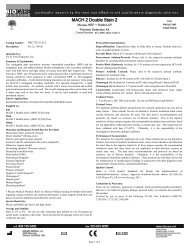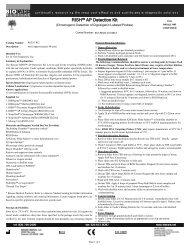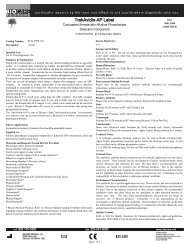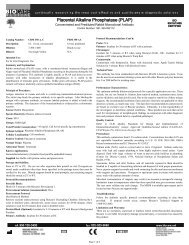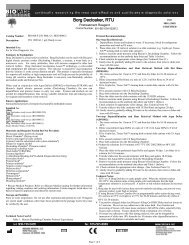Cytokeratin 7 (CK7)
Cytokeratin 7 (CK7)
Cytokeratin 7 (CK7)
Create successful ePaper yourself
Turn your PDF publications into a flip-book with our unique Google optimized e-Paper software.
<strong>Cytokeratin</strong> 7 (<strong>CK7</strong>)<br />
Concentrated and Prediluted Monoclonal Antibody<br />
Control Number: 901-061-022114<br />
ISO<br />
9001&13485<br />
CERTIFIED<br />
Catalog Number: CM 061 A, B, C PM 061 AA<br />
Description:<br />
Intended Use:<br />
For In Vitro Diagnostic Use<br />
<strong>Cytokeratin</strong> 7 (<strong>CK7</strong>) [OV-TL 12/30] is a mouse monoclonal antibody that is intended<br />
for laboratory use in the qualitative identification of cytokeratin 7 (<strong>CK7</strong>) protein by<br />
immunohistochemistry (IHC) in formalin-fixed paraffin-embedded (FFPE) human<br />
tissues. The clinical interpretation of any staining or its absence should be<br />
complemented by morphological studies using proper controls and should be evaluated<br />
within the context of the patient’s clinical history and other diagnostic tests by a<br />
qualified pathologist.<br />
Summary and Explanation:<br />
0.1, 0.5, 1.0 ml, concentrated<br />
6.0 ml, prediluted<br />
Dilution: 1:100-1:400 Ready-to-use<br />
Diluent: Da Vinci Green N/A<br />
<strong>Cytokeratin</strong> 7 is an intermediate filament protein (IFP) of 54 kDa that recognizes the<br />
simple epithelium found in most glandular and transitional epithelia; but not that which<br />
is found in stratified squamous epithelia. This monoclonal antibody [clone OV-TL<br />
12/30] is highly specific to cytokeratin 7 and shows no cross-reaction with other IFPs.<br />
<strong>Cytokeratin</strong> 7 is a basic cytokeratin, and is expressed in epithelial cells of ovary, lung,<br />
and breast, but not of colon or gastrointestinal tract. It is often used in conjunction with<br />
cytokeratin 20 in distinguishing ovarian, pulmonary, and breast carcinomas (<strong>CK7</strong>+)<br />
from colon carcinomas (<strong>CK7</strong>-).<br />
Principle of Procedure:<br />
Antigen detection in tissues and cells is a multi-step immunohistochemical process.<br />
The initial step binds the primary antibody to its specific epitope. A secondary antibody<br />
may be applied to bind the primary antibody, followed by an enzyme labeled polymer;<br />
or an enzyme labeled polymer may be applied directly to bind the primary antibody.<br />
The detection of the bound primary antibody is evidenced by an enzyme-mediated<br />
colorimetric reaction.<br />
Source: Mouse monoclonal<br />
Species Reactivity: Human; others not tested<br />
Clone: OV-TL 12/30<br />
Isotype: IgG1<br />
Total Protein Concentration: ~10 mg/ml. Call for lot specific Ig concentration.<br />
Epitope/Antigen: <strong>CK7</strong><br />
Cellular Localization: Cytoplasmic<br />
Positive Control: Ovarian or breast cancer<br />
Known Applications:<br />
Immunohistochemistry (formalin-fixed paraffin-embedded tissues)<br />
Supplied As: Buffer with protein carrier and preservative<br />
Storage and Stability:<br />
Store at 2ºC to 8ºC. Do not use after expiration date printed on vial. If reagents are<br />
stored under conditions other than those specified in the package insert, they must be<br />
verified by the user. Diluted reagents should be used promptly; any remaining reagent<br />
should be stored at 2ºC to 8ºC.<br />
Protocol Recommendations:<br />
Peroxide Block: Block for 5 minutes with Biocare's Peroxidazed 1.<br />
Pretreatment Solution (recommended): Reveal or Pepsin<br />
Pretreatment Protocol:<br />
Heat Retrieval Method:<br />
Retrieve sections under pressure using Biocare's Decloaking Chamber, followed by a<br />
wash in distilled water; alternatively, steam tissue sections for 45-60 minutes. Allow<br />
solution to cool for 10 minutes then wash in distilled water.<br />
Digestion Method:<br />
Digest with Pepsin enzyme for 5 minutes at 37ºC -or- for 15 minutes at RT.<br />
OAI 061 T70<br />
70 tests, prediluted<br />
Ready-to-use<br />
N/A<br />
Protocol Recommendations Cont'd:<br />
Protein Block (Optional): Incubate for 5-10 minutes at RT with Biocare's Background<br />
Punisher.<br />
Primary Antibody: Incubate for 30 minutes at RT.<br />
Probe: Incubate for 10 minutes at RT with a secondary probe.<br />
Polymer: Incubate for 10 minutes at RT with a tertiary polymer.<br />
Chromogen:<br />
Incubate for 5 minutes at RT with Biocare's DAB - OR - Incubate for 5-7 minutes at<br />
RT with Biocare's Warp Red.<br />
Counterstain:<br />
Counterstain with hematoxylin. Rinse with deionized water. Apply Tacha's Bluing<br />
Solution for 1 minute. Rinse with deionized water.<br />
Technical Note:<br />
This antibody has been standardized with Biocare's MACH 4 detection system. It can<br />
also be used on an automated staining system and with other Biocare polymer detection<br />
kits. Use TBS for washing steps.<br />
Protocol Recommendations (ONCORE Automated Slide Staining System):<br />
OAI061 is intended for use with the ONCORE Automated Slide Staining System.<br />
Refer to the ONCORE Automated Slide Staining System User Manual for specific<br />
instructions on its use. Protocol parameters in the ONCORE Automated Slide Stainer<br />
Protocol Editor should be programmed as follows:<br />
Protocol Name: <strong>CK7</strong><br />
Protocol Template (Description): Ms HRP Template 1<br />
Dewaxing (DS Option): DS2<br />
Antigen Retrieval (AR Option): AR2, low pH; 101°C<br />
Reagent Name, Time, Temp.: <strong>CK7</strong>, 30 min., 25°C<br />
Limitations:<br />
The optimum antibody dilution and protocols for a specific application can vary. These<br />
include, but are not limited to: fixation, heat-retrieval method, incubation times, tissue<br />
section thickness and detection kit used. Due to the superior sensitivity of these unique<br />
reagents, the recommended incubation times and titers listed are not applicable to other<br />
detection systems, as results may vary. The data sheet recommendations and protocols<br />
are based on exclusive use of Biocare products. Ultimately, it is the responsibility of<br />
the investigator to determine optimal conditions. The clinical interpretation of any<br />
positive or negative staining should be evaluated within the context of clinical<br />
presentation, morphology and other histopathological criteria by a qualified<br />
pathologist. The clinical interpretation of any positive or negative staining should be<br />
complemented by morphological studies using proper positive and negative internal<br />
and external controls as well as other diagnostic tests.<br />
Quality Control:<br />
Refer to CLSI Quality Standards for Design and Implementation of<br />
Immunohistochemistry Assays; Approved Guideline-Second edition (I/LA28-A2).<br />
CLSI Wayne, PA, USA (www.clsi.org). 2011.<br />
Precautions:<br />
1. This antibody contains less than 0.1% sodium azide. Concentrations less than 0.1%<br />
are not reportable hazardous materials according to U.S. 29 CFR 1910.1200, OSHA<br />
Hazard communication and EC Directive 91/155/EC. Sodium azide (NaN 3 ) used as a<br />
preservative is toxic if ingested. Sodium azide may react with lead and copper<br />
plumbing to form highly explosive metal azides. Upon disposal, flush with large<br />
volumes of water to prevent azide build-up in plumbing. (Center for Disease Control,<br />
1976, National Institute of Occupational Safety and Health, 1976) (7)<br />
Page 1 of 2
<strong>Cytokeratin</strong> 7 (<strong>CK7</strong>)<br />
Concentrated and Prediluted Monoclonal Antibody<br />
Control Number: 901-061-022114<br />
ISO<br />
9001&13485<br />
CERTIFIED<br />
Precautions Cont'd:<br />
2. Specimens, before and after fixation, and all materials exposed to them should be<br />
handled as if capable of transmitting infection and disposed of with proper precautions.<br />
Never pipette reagents by mouth and avoid contacting the skin and mucous membranes<br />
with reagents and specimens. If reagents or specimens come in contact with sensitive<br />
areas, wash with copious amounts of water. (8)<br />
3. Microbial contamination of reagents may result in an increase in nonspecific<br />
staining.<br />
4. Incubation times or temperatures other than those specified may give erroneous<br />
results. The user must validate any such change.<br />
5. Do not use reagent after the expiration date printed on the vial.<br />
6. The MSDS is available upon request and is located at http://biocare.<br />
net/support/msds/.<br />
References:<br />
1. Lagendijk JH, et al. Tracing the origin of adenocarcinomas with unknown primary<br />
using immunohistochemistry: differential diagnosis between colonic and ovarian<br />
carcinomas as primary sites. Hum Pathol. 1998 May;29(5):491-7.<br />
2. Tan J, et al. Villin, cytokeratin 7, and cytokeratin 20 expression in pulmonary<br />
adenocarcinoma with ultrastructural evidence of microvilli with rootlets. Hum Pathol.<br />
1998 Apr;29(4):390-6.<br />
3. Bouwens L. <strong>Cytokeratin</strong>s and cell differentiation in the pancreas. J Pathol. 1998<br />
Mar;184(3):234-9.<br />
4. Loy TS, Calaluce RD, Keeney GL. <strong>Cytokeratin</strong> immunostaining in differentiating<br />
primary ovarian carcinoma from metastatic colonic adenocarcinoma. Mod Pathol. 1996<br />
Nov;9(11):1040-4.<br />
5. Wauters CC, et al. Keratins 7 and 20 as diagnostic markers of carcinomas metastatic<br />
to the ovary. Hum Pathol. 1995 Aug;26(8):852-5.<br />
6. Loy TS, Calaluce RD. Utility of cytokeratin immunostaining in separating<br />
pulmonary adenocarcinomas from colonic adenocarcinomas. Am J Clin Pathol. 1994<br />
Dec;102(6):764-7.<br />
7. Center for Disease Control Manual. Guide: Safety Management, NO. CDC-22,<br />
Atlanta, GA. April 30, 1976 "Decontamination of Laboratory Sink Drains to Remove<br />
Azide Salts."<br />
8. Clinical and Laboratory Standards Institute (CLSI). Protection of Laboratory<br />
workers from occupationally Acquired Infections; Approved guideline-Third Edition<br />
CLSI document M29-A3 Wayne, PA 2005.<br />
Troubleshooting:<br />
Follow the antibody specific protocol recommendations according to data sheet<br />
provided. If atypical results occur, contact Biocare's Technical Support at<br />
1-800-542-2002.<br />
Page 2 of 2


